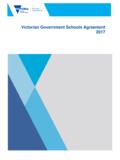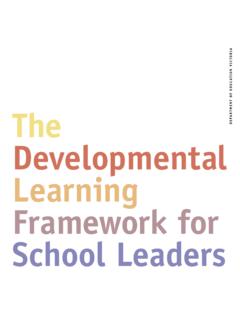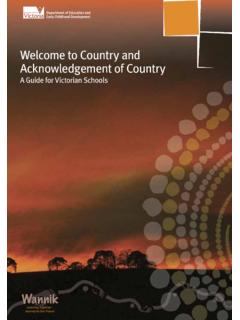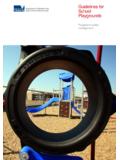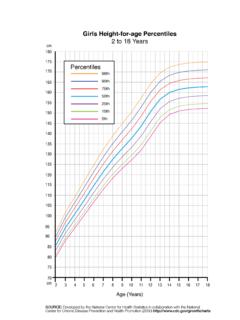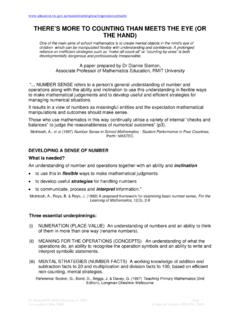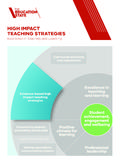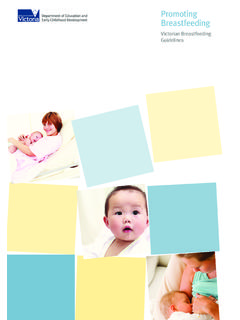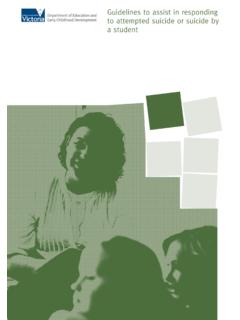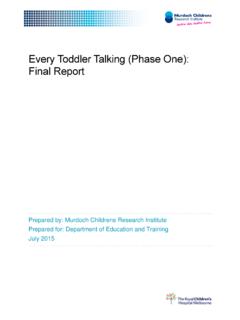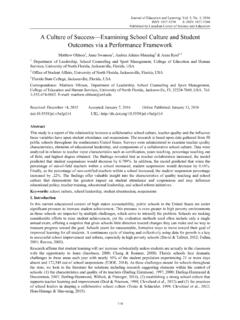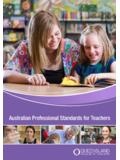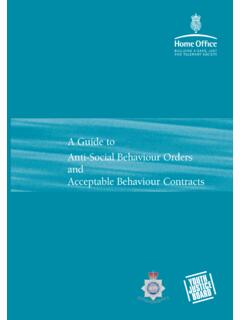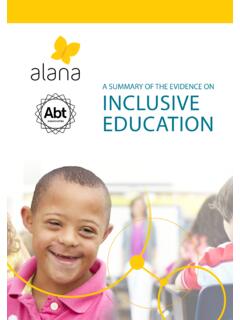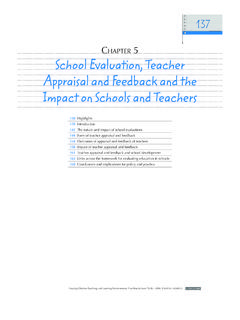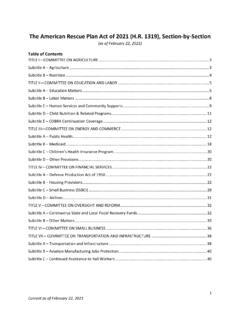Transcription of A Whole-School Guide to Curriculum Planning
1 1 | A Whole-School Guide to Curriculum PlanningA Whole-School Guide to Curriculum PlanningIf you would like to receive this publication in an accessible format, such as large print or audio, please telephone (03) 9637 2000 (TTY) This document is also available in PDF and Word formats on the internet at Department of Education and Training acknowledges and pays respect to Elders and all Victorian Aboriginal communities. We honour and respect Traditional Owners, past and present, and value the rich culture and history of the First Peoples of this land. Throughout this document the term Koorie is used to refer to both Aboriginal and Torres Strait Islander people. Use of the terms Aboriginal, Aboriginal and Torres Strait Islander and Indigenous are retained in the names of programs and initiatives and unless noted otherwise are inclusive of all Aboriginal and Torres Strait Islander by the Department of Education and TrainingMelbourne January 2020 State of Victoria (Department of Education and Training) 2020 The copyright in this document is owned by the State of Victoria (Department of Education and Training), or in the case of some materials, by third parties (third party materials).
2 No part may be reproduced by any process except in accordance with the provisions of the Copyright Act 1968, the National Education Access Licence for Schools (NEALS) (see below), or with educational institution situated in Australia which is not conducted for profit, or a body responsible for administering such an institution may copy and communicate the materials, other than third party materials, for the educational purposes of the by the Department of Education and Training, 2 Treasury Place, East Melbourne, Victoria, 3002. 3 | A Whole-School Guide to Curriculum PlanningA Whole-School Guide to Curriculum Planning | 3 ContentsCurriculum Planning is essential to student learning growth 4 How this Guide can help you 5 Framework for Improving Student Outcomes 6 Victorian Teaching and Learning Model 7 Victorian Curriculum F-10: An overview 8 Why a Whole-School approach? 9 Evaluate and diagnose 10 Prioritise and set goals 12 Develop and plan 14 Implement and monitor 16 Effective teaching is the single biggest determinant of student improvement in Framework for Improving Student Outcomes (FISO) uses contemporary research to help schools focus their efforts on key areas that are known to have the greatest impact on improved student outcomes.
3 FISO identifies that effective teaching is the single biggest determinant of student improvement in schools. Effective teaching and learning takes place in schools where teachers: have a deep knowledge of the Curriculum are prepared with strong content knowledge in key learning areas have the skills to utilise high-impact pedagogical strategies, suited to the Curriculum content, to improve student research has reinforced the powerful and positive impact of high-quality Curriculum on student Victorian Curriculum F-10 sets out what every student should have the opportunity to learn during their first eleven years of schooling. Incorporating the Australian Curriculum , it reflects Victorian standards and priorities and is the Curriculum for all Victorian government schools. Students and their needs are at the centre of Curriculum Planning . Schools design, plan and implement the Curriculum to equip their students with the knowledge, skills and attributes they need to complete their schooling and to make a successful transition to work, training or further Education and Training reform Regulations 2017 require all registered schools to have a Curriculum framework in place:a.
4 For the organisation and implementation of the school s Curriculum and teaching practicesb. to ensure that, taken as a whole , eight key learning areas are substantially addressed c. to provide for the review of the Curriculum and teaching Guide has been developed to support schools to adopt an effective Whole-School approach to Curriculum Planning . While the Guide focuses on the Victorian Curriculum F-10 (which includes Levels A-D), schools can also use the Guide to support Planning of the senior secondary Curriculum , or the Victorian Early Years Learning and Development Framework. Curriculum Planning is essential to student learning growth Great teachers don t rely just on textbooks or materials as is, but can adapt Curriculum for the needs of the students and based on their knowledge of the subject. (Marzano et al., 2005)5 | A Whole-School Guide to Curriculum PlanningHow this Guide can help youThe purpose of the Whole-School Guide to Curriculum Planning is to provide practical support for teachers, instructional leaders and school leaders to plan and implement the Curriculum at every layer of the school .
5 Using the FISO Improvement Cycle, the Guide presents a series of guiding questions and key actions to support Planning for the whole school , for a Curriculum area or year level, and for units and lessons. The purpose of the Guide is not to present an exhaustive list of actions for schools, nor to provide a checklist for Curriculum coverage. Rather, guiding questions invite reflection and self-assessment, to encourage teachers, instructional leaders and school leaders to build collective efficacy and plan for the implementation of the Curriculum throughout the school to improve learning for all students. Curriculum Planning at every layer of the schoolThe Guide also provides links to an extensive range of resources, case studies and templates that teachers, instructional leaders and school leaders can draw upon when they are doing this for the different layers of Curriculum Planning will vary across schools.
6 Part of the role of school leaders is to establish the systems and processes for effective Planning throughout the school . For example, in some schools: Whole-School Curriculum Planning may be led by school Improvement Teamsplanning for Curriculum areas or year levels may be undertaken by teams of teachers including an instructional leader, working in professional learning communities. Planning for units and lessons may also be undertaken in teams, or by individual schools will already have in place many features of effective Whole-School Curriculum Planning . The FISO Improvement Cycle emphasises that the Planning and implementation of the Curriculum is an ongoing process, subject to monitoring, evaluation and adaption. Schools can use the Guide to identify and implement strategies to build teachers knowledge and capability, and to ensure that the school s teaching and learning program continues to meet the evolving learning needs of all students, including English as an Additional Language learners, students with learning difficulties, Koorie students and high-ability school is unique and schools are invited to tailor the application of the Guide depending on the context of their schools, students and communities.
7 Prioritise and set goalsDevelop and planEvaluate and diagnoseImplement and monitorPlanning for the wholeschool Planning for a year level of Curriculum area Planning for units and lessons Framework for Improving Student OutcomesTo improve student outcomes, the FISO Essential Elements for school Improvement need to be Essential Elements underpin FISO and are present across all Priority Areas. This Guide directly supports schools to implement FISO Essential Element 1: Documented Curriculum plan, assessment and shared pedagogical school s documented Curriculum plan is informed by strategic and annual implementation Planning . It is regularly reviewed and updated by teams of teachers. The school allocates time and resources for teachers to share pedagogical content knowledge about the Curriculum , the implementation and monitoring of effective learning programs, and the Planning of content-specific instruction.
8 The assessment plan includes formative and summative Planning and assessment is also one of the six high-impact improvement initiatives in the FISO Improvement Model. These initiatives have been prioritised because they have the highest impact on improving student outcomes. The FISO Continua of Practice describe a range of practices across proficiency levels (Emerging, Evolving, Embedding and Excelling), including for Curriculum Planning and assessment. school leaders and teachers can use the Continua to self-evaluate their current practice, locate their performance on an improvement-focused continuum, and understand what improved practice looks Planning and assessmentEvidence-based high impact teaching strategiesEvaluating impact on learningParents and carers as partnersGlobal citizenshipNetworks with schools, services and agenciesBuildingcommunitiesBuilding practiceexcellenceExcellence in teaching and learningPositive climate for learningProfessionalleadershipCommunity engagement in learningStudent achievement.
9 Engagement and wellbeingEmpowering students and building school prideHealth and wellbeingSetting expectations and promoting inclusionIntellectual engagement and self awarenessInstructional and shared leadershipStrategic resource managementVision values and cultureBuilding leadership teams What you teach is as important as how you teach it, and the better your teaching craft, the greater the benefits resulting from a choice of rigorous content. (Lemov 2015)FISO Improvement ModelVictorian Teaching and Learning ModelCurriculum Planning is also a feature of the Victorian Teaching and Learning Model, which includes the Practice Principles for Excellence in Teaching and Practice Principles are signature pedagogies which make the difference , and research has explicitly linked them to improved student achievement and motivation. The fourth Practice Principle is Curriculum Planning and assessment engages and challenges all students.
10 When learning plans integrate the Victorian Curriculum , instructional practices and assessment strategies into coherent, sequential and contextually relevant programs, they can address the learning needs of all | A Whole-School Guide to Curriculum PlanningVictorian Curriculum F-10: An overviewThe Victorian Curriculum F 10 sets out what every student should learn during their first eleven years of schooling. The Curriculum provides a single, coherent and comprehensive set of content descriptions and associated achievement standards to enable teachers to plan, assess and report on the learning achievement of every student. The Victorian Curriculum F-10 now includes the new English as an Additional Language Victorian Curriculum F 10 includes knowledge and skills, which are organised under eight learning areas and four capabilities. The capabilities are a set of discrete knowledge and skills that can and should be taught explicitly in and through the learning areas, but are not fully defined by any of the learning areas.
